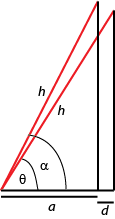Trig reps
Problem
The trigonometric functions $\sin(x)$ and $\cos(x)$ are of fundamental importance in advanced mathematics, both pure and applied. They have many beautiful mathematical properties. Sine and cosine are usually first encountered in the context of right-angled triangles, but mathematicians usually use alternative definitions for more advanced work.
Here are three different ways of representing the sine and cosine functions
1. Through ratios of the sides of right angled triangles:

$\cos(\theta) = \frac{a+d}{h}\quad \cos(\alpha) = \frac{a}{h}$
$\sin(\theta) = \frac{\sqrt{h^2-(a+d)^2}}{h}\quad\quad\sin(\alpha) = \frac{\sqrt{h^2-a^2}}{h}$
2. Through power series:
$$\cos(x) = 1-\frac{x^2}{2!}+\frac{x^4}{4!}-\frac{x^6}{6!}+\cdots\quad\quad \sin(x) = x-\frac{x^3}{3!}+\frac{x^5}{5!}-\frac{x^7}{7!}+\cdots$$
3. Through $e$ and $i$:
$$\cos(x) = \frac{e^{i x} + e^{-ix}}{2}\quad\quad \sin(x) = \frac{e^{ix}-e^{-ix}}{2i}$$
How do these different definitions give rise to the familiar properties of trigonometry functions? Some representations give some of the properties very easily, whereas you might find it very difficult or even impossible to deduce some of the properties with one or more of the representations!
Tick off the cells in the table when you manage to find proofs noting whether the representation made it easy or difficult to deduce that property.
| Property | Triangles | Power Series | $e$ and $i$ |
| $(\cos x)^2+(\sin x)^2 =1$ | |||
| $\cos(0) =1 ,\quad \sin(0)=0$ | |||
| $\sin(a+b)=\sin(a)\cos(b)+\cos(a)\sin(b)$ | |||
| $\cos(2x) = 2\cos^2(x)-1$ | |||
| $\cos(x+\pi) = -\cos(x),\quad \sin(x+\pi) = -\sin(x)$ | |||
| $\frac{d}{dx}(\sin(x)) = \cos(x), \quad \frac{d}{dx}(\cos(x)) = -\sin(x)$ | |||
| $\cos\left(\frac{\pi}{2}\right) = 0, \quad \sin\left(\frac{\pi}{2}\right)=1$ | |||
| $|\cos(x)|\leq 1, \quad |\sin(x)|\leq 1$ | |||
| $\sin(x)\approx x \mbox{ and } \cos(x) \approx 1-\frac{x^2}{2}$ when $|x|$ small. |
Teachers' Resources
Why do this problem?
This problem introduces students to different definitions or representations of trigonometric functions and challenges them to consider when each different representation is most useful.
Possible approach
Start by inviting students to discuss in pairs how they would define $\sin x$ and $\cos x$, and then share these discussions as a group. It is likely that they will consider trigonometric functions defined in terms of right-angled triangles. (Note that the diagram in the problem gives a slightly unusual representation of this definition- this representation hints at double angle formulae and calculus and might itself provoke some discussion).
Introduce the two other representations from the problem. The representations are all available on this worksheet .
Next, invite students to think of as many properties of sin and cos that they can think of, and list them on the board. This worksheet lists the properties given in the problem, and includes some blank rows for any the students think of for themselves that they wish to work on.
"For each property, use the three representations to see if you can deduce the property. It might be easier in some representations than others, and it might be impossible in some representations! Make a note in each cell of the table whether it was easy, difficult or impossible to prove."
Give students time to work on the task in pairs or small groups. As they are working, circulate and listen for clear explanations or insights about the benefits and limitations of the three representations. Finally, invite students out to the board to explain their proofs for each property and to comment on the three representations.
Key questions
Which representation makes it easy to prove this?
Is it possible to prove this using all three representations?
Possible extension
Students who readily solve this challenge could be given the power series and exponential definitions of sinh and cosh and asked to reconstruct a table of properties of sinh and cosh by analogy. This extension would work well if encountered before formally meeting sinh and cosh. Those students who have met sinh and cosh might additionally be asked to construct an analogue of the first trig rep for the hyperbolic functions.
Possible support
The animation in Round and Round a Circle could be used as an introduction for students whose understanding of the right-angled triangle representation is not secure.
